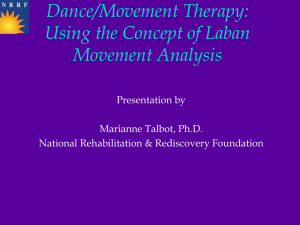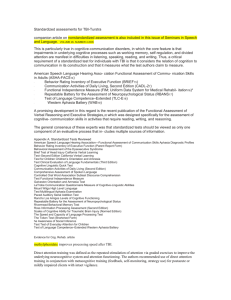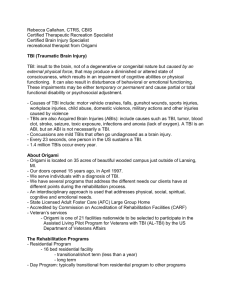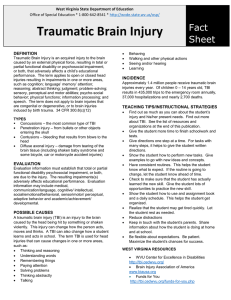Report on the Workshop on Advancing Assisted Cognition Technology
advertisement
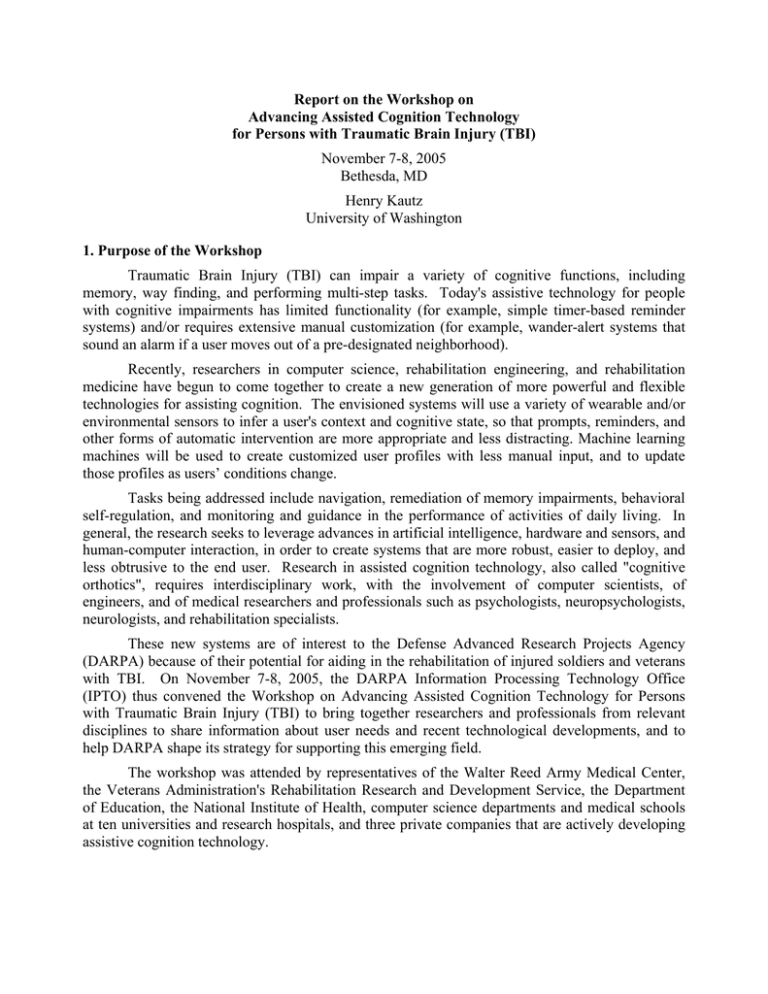
Report on the Workshop on Advancing Assisted Cognition Technology for Persons with Traumatic Brain Injury (TBI) November 7-8, 2005 Bethesda, MD Henry Kautz University of Washington 1. Purpose of the Workshop Traumatic Brain Injury (TBI) can impair a variety of cognitive functions, including memory, way finding, and performing multi-step tasks. Today's assistive technology for people with cognitive impairments has limited functionality (for example, simple timer-based reminder systems) and/or requires extensive manual customization (for example, wander-alert systems that sound an alarm if a user moves out of a pre-designated neighborhood). Recently, researchers in computer science, rehabilitation engineering, and rehabilitation medicine have begun to come together to create a new generation of more powerful and flexible technologies for assisting cognition. The envisioned systems will use a variety of wearable and/or environmental sensors to infer a user's context and cognitive state, so that prompts, reminders, and other forms of automatic intervention are more appropriate and less distracting. Machine learning machines will be used to create customized user profiles with less manual input, and to update those profiles as users’ conditions change. Tasks being addressed include navigation, remediation of memory impairments, behavioral self-regulation, and monitoring and guidance in the performance of activities of daily living. In general, the research seeks to leverage advances in artificial intelligence, hardware and sensors, and human-computer interaction, in order to create systems that are more robust, easier to deploy, and less obtrusive to the end user. Research in assisted cognition technology, also called "cognitive orthotics", requires interdisciplinary work, with the involvement of computer scientists, of engineers, and of medical researchers and professionals such as psychologists, neuropsychologists, neurologists, and rehabilitation specialists. These new systems are of interest to the Defense Advanced Research Projects Agency (DARPA) because of their potential for aiding in the rehabilitation of injured soldiers and veterans with TBI. On November 7-8, 2005, the DARPA Information Processing Technology Office (IPTO) thus convened the Workshop on Advancing Assisted Cognition Technology for Persons with Traumatic Brain Injury (TBI) to bring together researchers and professionals from relevant disciplines to share information about user needs and recent technological developments, and to help DARPA shape its strategy for supporting this emerging field. The workshop was attended by representatives of the Walter Reed Army Medical Center, the Veterans Administration's Rehabilitation Research and Development Service, the Department of Education, the National Institute of Health, computer science departments and medical schools at ten universities and research hospitals, and three private companies that are actively developing assistive cognition technology. 2. Workshop Outcomes The workshop began with a series of talks by medical experts on the symptoms and needs of persons with traumatic brain injury, followed by presentations about current research and development of assistive technology for persons with cognitive impairments. These talks are described in more detail in Section 3 of this report. The second day of the workshop was devoted to discussions of stakeholder needs, dimensions of assisted cognition systems, categories of applications, the required technological scaffolding, and ways to measure progress. The participants reached remarkable consensus on these issues, which are summarized in the following annotated outline. 1. Stakeholders Needs The stakeholders are the injured soldiers and veterans, their families and caregivers, rehabilitation service providers, employers and schools, and funding agencies, such as the Defense Department, VA, NIDRR, NIH, Medicare, and insurers. 1.1. Injured Soldiers' Needs Injured soldiers present with a variety of potentially debilitation changes that are commonly encountered in a TBI population. These problems can be categorized as follows: a) cognitive changes affecting primary skills such as attention, verbal and perceptual memory, language based skills and perceptual reasoning; b) executive control dysfunction affecting decision-making capability, strategy formation, cognitive control, the development and implementation of plans, activity initiation and awareness of the passage of time; c) emotional, behavioral and social/interpersonal changes including difficulties with self-regulation, mood stability; selfawareness of cognitive and behavior changes, and the ability to judge when that behavior is appropriate; and d) various perceptual impairments including the ability to find oneself in space, understanding the relationship of one's body to space and objects in space, and understanding how objects in space relate to one another. As a result of these changes, occurring in various combinations, TBI typically reduces an individual's capacity to perform simple tasks as well as handle simultaneous activities and unexpected events. Solving a simple problem can require a person's full concentration. It is common for a person with TBI to become overwhelmed and immobilized in complex problemsolving or emotionally charged situations. The symptoms of TBI are highly variable. For example, some survivors may have changes in emotional regulation, such as being quick to anger; and others may be happy but overly passive. These issues may be complicated by concurrent difficulties with expressive and receptive communication for some, and others may frequently become lost and disoriented, and fear traveling independently in their community. This variability means that there can be no one size fits all solution to TBI; assistance must be customized and adaptable. TBI-related changes can make it difficult for a person to hold down a job and maintain a successful social and home life. For example, a person may use an inappropriately loud voice in talking to a co-worker, lose track of time while taking a coffee break, or fail to recognize errors in work completed. While the functional limitations associated with TBI are highly variable, the ultimate life goals of a person with TBI can be concisely summarized as participating fully in work, community, and family, the same as for all people. Work on assistive technology should be mindful of how the technology helps the user achieve these ultimate goals, rather than focusing only on the specific details of particular impairments. 1.2 Caregiver and Therapist Needs Family caregivers are often overwhelmed with the burden of caring for a person with TBI. They desire a way to ensure the personal safety of their family member when left alone for some period of time. Even if the caregiver is physically present, ways to help the person with TBI be more self-directed are desirable, because the person with TBI may often feel resentment towards a caregiver who is (necessarily) always telling him what to do. Therapists need better diagnostic and data collection tools. In particular, they need a way to record the objective reality of a person with TBI’s behavior in his/her home and work environments. Therapists similarly need ways to measure treatment response in a natural setting, including sustained response over time. The ability to measure behavior in natural settings would be a breakthrough in treatment and care of persons with TBI, because behavior in a clinical setting can be very different from behavior at home or work. Furthermore, there is evidence that cognitive rehabilitation interventions in a laboratory settings on artificial tasks fail to generalize to the performance of real world tasks. 2. Dimensions of Assisted Cognition Systems Assisted cognition applications can be categorized along different orthogonal dimensions: 2.1 Remediation versus replacement: Although some aspects of brain function are plastic and can improve over time in survivors of TBI, many symptoms are permanent. Assisted cognition technology by and large aims to replace rather than remediate diminished function. Assisted cognition systems can be thought of as "wheelchairs for the brain.” It should be noted, however, that recent advances in the study of neuroplasticity raises the possibility that systems designed to provide remediation may actually induce plasticity if used intensively, consistently, and within a functional context. 2.2 Monitoring versus interaction: Systems that monitor and record a user's behavior for later review are useful for diagnosis and evaluation of treatments. Interactive systems go further in providing real-time interventions, such as prompts and warnings. 2.3 End-user: Related to the previous dimension, the output of the system may be directed to the person with TBI, to his or her family, to professional therapists or caregivers, or some combination of these. 2.4 Sensors: Systems may detect key behaviors, and thereby infer the state of the person with TBI, by means of instruments in the environment, by sensors worn by the person with TBI, or both. In all cases, issues of privacy and security of the collected data are paramount. 3. Categories of Assisted Cognition Systems Different assisted cognition systems address different needs. There was general agreement among the workshop participants that successful systems will target specific, contextually-defined behaviors and activities, rather than broad horizontal functions such as "memory". Kinds of needs include: 3.1 Social pragmatics Social pragmatics covers the ways in which a person with TBI interacts with other people at home and work. The ability to measure and enhance a patients' social pragmatics has the potential to help with many of the other problems associated with TBI. For example, simply being able to take coarse measurements of a person’s communication pragmatics, based on speech loudness, distance to other persons, and duration of speech, would be an important diagnostic tool, and could be used to provide feedback to the user to improve social skills. 3.2 Navigation Certain kinds of brain trauma impair a person's ability to stay oriented in space. The individual may become lost even in a familiar neighborhood. Problems with spatial awareness can be compounded by impaired executive function when the person with TBI needs to complete a multi-step navigation plan, such as taking public transportation to and from work. An additional complication is that impaired self-initiation may prevent a patient from taking action if he becomes lost; instead of asking for help, he may "freeze". Assisted cognition technology can support navigation by monitoring a user's movements with GPS-type technology and proactively providing help when it appears that the user is lost or confused. 3.3 Emotional self-regulation Persons with TBI are often subject to exaggerated mood swings. For example, a trivial problem may send the person into a rage or despair. Many people can learn to moderate their mood swings by consciously applying various cognitive strategies when a triggering situation begins to occur (e.g., "if you start to get angry, take a deep breath and count to ten"). For a person with TBI, however, applying such cognitive strategies may be problematic, because of diminished selfawareness of one's own affective state, until the emotion is too strong to be controlled. Simple cueing systems that provide fixed interval cues to initiate a behavioral strategy can be very helpful. Some cueing systems can be incorporated into a behavior change regimen, starting with real-time cueing by a caregiver, and then systematically fading out as the person with TBI demonstrates the ability to respond to less intensive cueing routines. More technologically sophisticated assisted cognition devices for emotional self-regulation could detect various behavioral and physiological signals that predict an oncoming mood swing, and provide an explicit feedback signal to the user. 3.4 Activity planning, initiation, and performance Impaired executive function in TBI crucially impacts a person's ability to form plans for future actions, to initiate plan execution in a timely fashion, and to monitor their own plan performance. Therefore, a major class of assisted cognition devices are those that support various aspects of planning and plan execution. Such systems may help in planning a day's activities, provide prompts to initiate simple activities, and/or provide detailed, step-by-step guidance through complex tasks. Information obtained from sensors monitoring plan performance can be used to ensure that the information provided is tailored more to the needs of the individual user. 4. Technological Scaffolding The scaffolding for assisted cognition systems will require advancing and integrating various technologies. These include: 4.1. Ways to specify and/or learn models of everyday activities, including both hard and soft physical and social constraints on human behavior; 4.2. Methods for collecting and integrating heterogeneous sensor data, including seamless transitions from indoor to outdoor environments; 4.3. Algorithms for high-level state estimation from noisy data, including both the behavioral and cognitive state of the user; 4.4. Methods for deciding when and how the system should intervene; 4.5. User interfaces that are usable by persons with TBI and by their caregivers, and that can be automatically and/or manually customized to the needs of the individual; 4.6. Data mining and analysis methods to discover long-term patterns of behavior and correlations between interventions and effects; 4.7. Robust power management methods, so that systems can be practically deployed for long periods of time; 4.8. Ecologically valid assessment tools: that is, tools to assess behavior in real-world, nonclinical environments; and in particular, tools for capturing behavior in natural environments and then providing virtual reality playback for third-person review and evaluation. 5. Measuring Progress Nearly all evaluations to date of assisted cognition systems have been single-user studies. There is great difficulty in performing meaningful controlled trials, due to the large variability in the TBI subject population. On the other hand, while single-user studies are generally considered adequate for pilot studies, they do not generate the compelling data required for higher level decision making by the N.I.H. and other medical funding agencies. Furthermore, much work on assisted cognition systems is in early stages, and not yet ready for even a formal single-user study. None the less, a few controlled clinical trials of assisted cognition systems have recently begun on commercial PDA-based systems for delivering scripted prompts and reminders (representatives of the companies, AbleLink and Attention Control Systems, presented talks at the workshop.) No clinical evaluations of sensor-based assisted cognition systems have yet been performed. A further, and most critical, complication is that there simply do not exist adequate welldefined and well-accepted ways to measure the performance of an assisted cognition system. There was some discussion of a particular proprietary system for measuring activity of daily living performance that has seen some use in England. That method, however, is not an open standard that anyone can use, and has various other shortcomings. The workshop participants agreed that the assisted cognition research community needs to develop its own metrics. Metrics would correspond to particular behaviors that are affected by TBI. Goal attainment scaling is an analytic methodology that allows researchers to scale multiple individualized outcomes across subjects in treatment and control conditions to evaluate the efficacy of the intervention. For each behavior, one could measure (1) the accuracy of the system in detecting the behavior, and/or (2) the change in the behavior over time as the subject uses the system. Events to be measured could include: Instances of inappropriate behaviors Instances of activities self-initiated on time Instances of ADLs performed correctly Instances of wayfinding tasks completed correctly Instances of appropriate social interactions Measurements should distinguish the context in which the behavior occurs. For example, measurements of ADL performance in a laboratory setting should be compared to measurements of those ADLs in a home or work setting. This is important because there is a history of computerbased cognitive rehabilitation therapies that appear to work in the lab, but do not transfer to real life. This key issue here, generalization, is a complex one. It may be possible to develop specific assistive technology interventions that promote generalization in various ways, but it is also likely that for many behaviors, generalization will not be possible to induce. In these cases, assistive technology systems must be designed so that small changes can be made to facilitate sustained adaptive behavior as new behavioral contexts are added to a user’s routines. Metrics should also measure the dependence of the subject on the assistive system, and how that might change over time. For example, one could measure the number of cues required for the subject to perform an ADL, or in a wayfinding application, the distance the subject can travel without prompts. In general, one would like a quantitative measure of both explicit goal attainment and dependence on technology. Knowing the relationship between these two kinds of measures is important for evaluating assistive technology. For example, if the subject's performance improves but the system never actually delivers any useful cues, then one might conclude that the improvement was merely due to the so-called Hawthorne effect (i.e., as a positive response to the subject’s perception of increased attention being paid by the researchers). At the other extreme, if the number of cues the system delivers rises over time, and the subject is undergoing any physiological decline, one might worry that the system is encouraging passivity. There was discussion of how work on evaluating assisted cognition systems could help promote a new approach to evaluating therapies that would be distinct from the traditional single trial or randomized clinical trial. The approach, called a "normalized individual behaviors" study, would measure the changes in a group of individuals, but the data for each individual would be normalized to account for that particular individual's degree of disability, before being aggregated across the group. Finally, workshop participants stressed that there were great needs for testing of existing technologies; data sharing between research groups, while maintaining privacy of test subjects; and in general, more interaction between the medical and computer science communities. 6. Overview of Talks What is Assisted Cognition? Henry Kautz, University of Washington, Department of Computer Science & Engineering. Presented a general architecture for assisted cognition systems, which links sensor data to behaviors, then to cognitive states, and finally to automated interventions. Brain Injury 101: Causes and Symptoms. Kathleen Bell, UW Medical Center, Brain Injury Rehabilitation Clinic. Provided an epidemiology of TBI, including risk factors, physical effects, and cognitive consequences. Cognitive Deficits and Compensatory Strategies Post-TBI. Kurt Johnson, UW Department of Rehabilitation Medicine. Described how TBI diminishes the "cognitive economy", and how structuring the environment and providing external aids can enhance cognitive efficiency. Community Integration of Individuals with Traumatic Brain Injury. Wayne A. Gordon, Mount Sinai School of Medicine. Summarized the functional impairments associated with TBI, and the implications of those impairments to the day-to-day life of the patient. Veterans with TBI. Deborah Warden, Walter Reed DVBIC. Described the common causes of TBI in veterans, the kind of care they receive at VA hospitals, and the challenges they face. Applying for Funding Research on TBI. Michael Weinrich, Director, National Center for Medical Rehabilitation Research, National Institute of Health. Described how NIH funding works, and some of the particular challenges for TBI research, because of the difficulty in doing randomized clinical trials for a complex "messy" injury. Stressed the need for a grant application to have a good research hypothesis, and suggested researchers consider applying for R21 "exploratory" grants. Navigation Assistance for Persons with Cognitive Disabilities. Washington, Department of Computer Science & Engineering. Henry Kautz, University of Described the development of a wayfinding assisted cognition system that uses GPS data to learn a user's pattern of movements and use of public transportation, and then provides proactive assistance in case of user errors. Automated Prompting of ADLs for Patients with Dementia. Alex Mihailidis, University of Toronto, Rehabilitation Engineering. Described the development of an automated handwashing and toileting assisted cognition system for persons with dementia. The system tracks user activity using video and provides appropriate voice prompts. Monitoring Activities of Daily Living. Matthai Philipose, Intel Research Seattle. Described the Intel SHARP project has shown that many activities of daily living can be recognized and tracked with high accuracy using data from a wearable RFID tag reader and tagged household objects. Adaptive Reminder Systems. Martha Pollack, University of Michigan, Computer Science. Presented Autominder, a personal planning, scheduling, and prompting system for persons with cognitive disabilities. Autominder adapts the prompts that it provides based on the current needs of its user. Communication Aids for People with Cognitive Disabilities. Alan Newell, Applied Computing, University of Dundee. Discussed a program at the University of Dundee, which has 30 researchers and 25 years of experience in developing assisted communication systems for persons with communication problems due to aging or cognitive impairments. The main goal is to help increase social communication and promote positive interactions with other people. TBI: Can Novel Neuro Engineering Harness Brain Plasticity to Enhance Outcome? Bruce Volpe, The Burke Medical Research Institute. Presented research with colleagues at MIT showing that physical therapy using a robotic exoskeleton can rehabilitate functioning after stroke. Research and Development of Cognitive Support Technologies, Daniel Davies, AbleLink Technologies. Described prompting and cueing systems developed by AbleLink since its founding in 1997, including PDA and cell phone based systems. Virtual Reality Simulation Technology for TBI Assessment and Rehabilitation Albert Rizzo, Institute for Creative Technologies and School of Gerontology, USC Presented a variety of virtual reality applications, such a virtual classroom that can be used to measure a student’s focus of attention in order to diagnose ADD. Rehabilitation Engineering Research Center for the Advancement of Cognitive Technologies (RERC-ACT). Cathy Bodine, University of Colorado. Described work at the University of Colorado RERC on assistive technology for people with cognitive disabilities due to mental retardation. Of note is a large-scale, randomized study of decision-support software for people with disabilities. Planning and Cueing Aids for Cognitive Disorders. Richard Levison, Attention Control Systems. The PEAT system provides prompting and cueing using activity scripts that describe a user's daily schedule. A clinical trial of PEAT has just begun, performed in conjunction with the Santa Clara Valley Medical Center. 7. Attendee Affiliation and Contact Information Ablowitz Enid Coleman Institute for Cognitive enid.ablowitz@cufund.org Disabilities Aisen Mindy formerly Veterans Administration MLAisen@aol.com Director RRD Araujo Gabriela DARPA IPTO support Bell Kathleen University of Washington, krbell@u.washington.edu Director, Medical Center Brain Injury Rehabilitation Clinic Bodine Cathy University of Colorado Health cathy.bodine@uchsc.edu Sciences gabriela.araujo.ctr@darpa.mil Brannon Ruth Department of Education, Dromerick Alexander National Rehabilitation Hospital Fraser Robert T. University of Washington, rfraser@u.washington.edu Director, Neurological Vocational Rehabilitation Unit French Louis Walter Reed Director Gage Doug DARPA IPTO support Glass Thomas Johns Hopkins Bloomberg School jglass@jhsph.edu of Public Health Gordon Wayne Mt Sinai School of Medicine, wayne.gordon@mssm.edu Director, Rehabilitation Research & Training Center on TBI Hogan Neville MIT Mechanical Engineering Hovda David University Angeles Jaeger Robert Department of Education, Office of Robert.Jaeger@ed.gov Special Education and Rehabilitative Services Johnson Kurt L. University of Washington, kjohnson@u.washington.edu Department of Rehabilitation Medicine, Director UW Center for Technology & Disability Studies Kautz Henry University of Washington, kautz@cs.washington.edu Computer Science, Director, Assisted Cognition Project Kirsch Ned Director, Adult Neurorehabilitation nlkirsch@umich.edu Day Program and the Michigan Assistive Technology for Cognition Program, Dept. of Physical Medicine and Rehabilitation, Univ. of Michigan Health Systems Krebs Hermano MIT Mechanical Engineering hikrebs@mit.edu Levison Richard Attention Control Systems rich@brainaid.com Lux Warren Walter Reed Director Maeda Mari DARPA IPTO mari.maeda@darpa.mil Malloy Luise DARPA IPTO support luise.malloy.ctr@darpa.mil of DVBIC, Ruth.Brannon@ed.gov Clinical louis.french@amedd.army.mil douggage@san.rr.com California, DVBIC, Alexander.W.Dromerick@medstar.net Los DHOVDA@MEDNET.UCLA.EDU Deputy warren.lux@amedd.army.mil McCary John DARPA IPTO john.mccary.ctr@darpa.mil Mihailidis Alex University of Toronto alex.mihailidis@utoronto.ca Rehabilitation Engineering Newell Alan University of Dundee, Dean of afn@computing.dundee.ac.uk Engineering Patterson Don University of California at Irvine, djp3@cs.washington.edu Information Science Philipose Matthai Intel Research SHARP Project Pollack Martha University of Michigan, Assoc. pollackm@eecs.umich.edu Chair for Computer Science and Eng., Dept. of Elec. Eng. and Computer Science Rizzo Skip University of Southern California Volpe Bruce The Burke Institute Warden Deborah Walter Reed DVBIC, Director Weinrich Michael National Institute for Child Health mw287k@nih.gov and Human Development, Director of the National Center for Medical Rehabilitation Research Seattle, Medical Head, matthai@intel-research.net arizzo@usc.edu Research bvolpe@burke.org deborah.warden@amedd.army.mil



